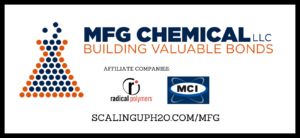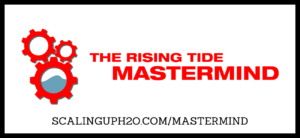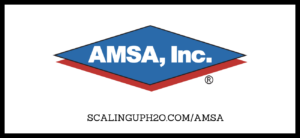 “Be the iron fist that keeps your water flowing clean and clear.” – Trace Blackmore
“Be the iron fist that keeps your water flowing clean and clear.” – Trace Blackmore
Welcome back to another insightful Pinks & Blues episode of Scaling UP! H2O! In this episode, host Trace Blackmore dives into the fascinating world of iron in water treatment systems. While iron is essential for life, it can be a major problem in industrial water systems, leading to corrosion, equipment damage, and inefficiencies. This episode unpacks the science behind iron, testing methods, and practical strategies for managing its impact.
Understanding the Iron Triangle
To effectively manage iron in water systems, it’s important to understand its different forms. Trace explains the Iron Triangle, breaking down the differences between elemental iron (Fe), ferrous iron (Fe2+), and ferric iron (Fe3+). He discusses how iron moves through water systems and why recognizing these distinctions is critical for water treatment professionals.
How to Test for Iron Accurately
Proper testing is key to managing iron levels. Trace details the phenanthroline method, a common technique used to measure iron concentrations in water. He provides best practices for accurate testing, discusses common interferences like molybdates and nitrites, and explains how to adjust testing methods to ensure reliable results.
Corrosion and Iron’s Impact on System Longevity
Iron is a major contributor to corrosion in water systems, and Trace explains why steel corrodes so easily. He covers the role of corrosion inhibitors and the importance of filtration systems in preventing excessive iron buildup. By managing iron effectively, professionals can protect equipment, reduce maintenance costs, and improve system efficiency.
Math in Action: Calculating Total Iron in a System
For those who love applying real-world math, Trace walks through the process of calculating total iron in pounds within a system. He explains how this calculation can help justify maintenance decisions and provide a compelling reason for clients to invest in proper water treatment solutions.
Takeaways: Why Iron Management Matters
This episode is packed with valuable insights for water professionals looking to improve their approach to iron management. From understanding the science behind iron to implementing better testing and corrosion prevention strategies, this discussion is designed to help you stay ahead in your field.
Have a water treatment question? Want to hear a topic covered in a future Pinks & Blues episode? Submit your ideas at ScalingUpH2O.com/showideas —your input helps shape future episodes! And remember, iron might be essential for our bodies, but in water systems, it’s a force to be reckoned with. Mastering iron control is key to maintaining system efficiency and preventing costly damage. Be the iron fist that keeps your water flowing clean and clear!
Stay engaged, keep learning, and continue scaling up your knowledge!
Timestamps
03:20 – Upcoming Events for Water Treatment Professionals
06:44– Water You Know with James McDonald
09:35 – Trace talks about Iron Historical Figure
15:28 – Iron that’s in Water Systems
17:39 – Understanding Corrosion & How It Impacts Your System
18:24 – The Iron Triangle
19:58 – The Phenanthroline Method
Quotes
“Steel is the most recycled material on this planet.”
“If you’re treating your tests like a task, you’re missing the magic of this industry.”
“Iron might be essential for our bodies, but it can be a real troublemaker when it’s dissolved in the water in our systems, so don’t let iron catch you off guard.”
Connect with Scaling UP! H2O
Submit a show idea: Submit a Show Idea
LinkedIn: in/traceblackmore/
YouTube: @ScalingUpH2O
Click HERE to Download Episode’s Discussion Guide
Scaling UP! H2O Resources Mentioned
AWT (Association of Water Technologies)
Scaling UP! H2O Academy video courses
How its Made Steel by How it’s Made Show
400 Celebrating 2024 and 400 Episodes!
399 Pinks and Blues: The Science of Serial Dilution
397 Pinks and Blues: How to look at your tests
Water You Know with James McDonald
Question: What is a plastic or rubber device that seals the outside of a reverse osmosis membrane against the inside wall of the pressure vessel to prevent feedwater from bypassing around the membrane element?
2025 Events for Water Professionals
Check out our Scaling UP! H2O Events Calendar where we’ve listed every event Water Treaters should be aware of by clicking HERE.



